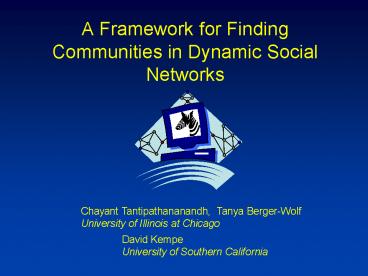A Framework for Finding Communities in Dynamic Social Networks
1 / 23
Title:
A Framework for Finding Communities in Dynamic Social Networks
Description:
1. t=1. t=2. t=3. t=4. t=5. Approach: Graph Model. 5. 5. 5. 5. 5. 1. 2. 3. 4. 1. 2. 3. 4. 1. 2. 3. 4. 1. 2 ... Problem Definition. Minimum Community Interpretation ... –
Number of Views:16
Avg rating:3.0/5.0
Title: A Framework for Finding Communities in Dynamic Social Networks
1
A Framework for Finding Communities in Dynamic
Social Networks
Chayant Tantipathananandh, Tanya
Berger-Wolf University of Illinois at Chicago
David Kempe University of Southern California
2
Social Networks
3
History of Interactions
t1
1
3
2
4
5
Assume discrete time and interactions in form of
complete subgraphs.
4
Community Identification
What is community?
Cohesive subgroups are subsets of actors among
whom there are relatively strong, direct,
intense, frequent, or positive ties. Wasserman
Faust 97
Notions of communities
Static
- Centrality and betweenness Girvan Newman 01
- Correlation clustering Basal et al. 02
- Overlapping cliques Palla et al. 05
Dynamic
- Metagroups Berger-Wolf Saia 06
5
The Question What is dynamic community?
5
4
3
2
1
t1
5
1
2
3
4
t2
4
1
5
2
t3
5
4
2
3
t4
4
5
1
2
3
t5
- A dynamic community is a subset of individuals
that stick together over time. - NOTE Communities ? Groups
6
Approach Graph Model
7
Approach Assumptions
Required
- Individuals and groups represent exactly one
community at a time. - Concurrent groups represent distinct communities.
Desired
- Conservatism community affiliation changes are
rare. - Group Loyalty individuals observed in a group
belong to the same community. - Parsimony few affiliations overall for each
individual.
8
Approach Color Community
Valid coloring distinct color of groups in each
time step
9
Approach Assumptions
Required
- Individuals and groups represent exactly one
community at a time. - Concurrent groups represent distinct communities.
Desired
- Conservatism community affiliation changes are
rare. - Group Loyalty individuals observed in a group
belong to the same community. - Parsimony few affiliations overall for each
individual.
10
Costs
- Conservatism switching cost (a)
- Group loyalty
- Being absent (ß1)
- Being different (ß2)
- Parsimony number of colors (?)
11
Approach Assumptions
Required
- Individuals and groups represent exactly one
community at a time. - Concurrent groups represent distinct communities.
Desired
- Conservatism community affiliation changes are
rare. - Group Loyalty individuals observed in a group
belong to the same community. - Parsimony few affiliations overall for each
individual.
12
Costs
- Conservatism switching cost (a)
- Group loyalty
- Being absent (ß1)
- Being different (ß2)
- Parsimony number of colors (?)
13
Approach Assumptions
Required
- Individuals and groups represent exactly one
community at a time. - Concurrent groups represent distinct communities.
Desired
- Conservatism community affiliation changes are
rare. - Group Loyalty individuals observed in a group
belong o the same community. - Parsimony few affiliations overall for each
individual.
14
Costs
- Conservatism switching cost (a)
- Group loyalty
- Being absent (ß1)
- Being different (ß2)
- Parsimony number of colors (?)
15
Problem Definition
- Minimum Community Interpretation For a given
cost setting, (a,ß1,ß2,?), find vertex coloring
that minimizes total cost. - Color of group vertices Community structure
- Color of individual vertices Affiliation
sequences - Problem is NP-Complete and APX-Hard
16
Model Validation and Algorithms
- Model validation exhaustive search for an exact
minimum-cost coloring. - Heuristic algorithms evaluation compare
heuristic results to OPT. - Validation on data sets with known communities
from simulation and social research - Southern Women data set (benchmark)
17
Southern Women Data Setby Davis, Gardner, and
Gardner, 1941
Aggregated network
Photograph by Ben Shaln, Natchez, MS, October
1935
Event participation
18
Ethnography
by Davis, Gardner, and Gardner, 1941
Core (1-4)
Periphery (5-7)
Periphery (11-12)
Core (13-15)
19
An Optimal Coloring (a,ß1,ß2,?)(1,1,3,1)
Core
Periphery
Core
Periphery
20
An Optimal Coloring (a,ß1,ß2,?)(1,1,1,1)
Core
Core
Periphery
21
Conclusions
- An optimization-based framework for finding
communities in dynamic social networks. - Finding an optimal solution is NP-Complete and
APX-Hard. - Model evaluation by exhaustive search.
- Heuristic algorithms for larger data sets.
Heuristic results comparable to optimal.
22
Thank You
Poster 6 this evening
23
Computational PopulationBiology
LabUIC compbio.cs.uic.edu
David KempeUSC
Dan RubensteinPrinceton
TanyaBerger-Wolf
Poster6 this evening
Jared SaiaUNM
Ilya Fischoff
Siva Sundaresan
Simon LevinPrinceton
MuthuGoogle
Mayank Lahiri
ChayantTantipathananandh
Habiba































